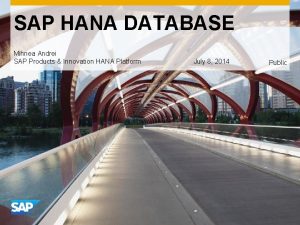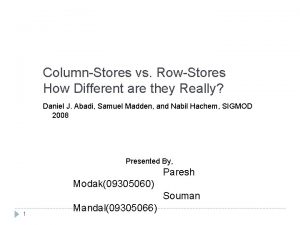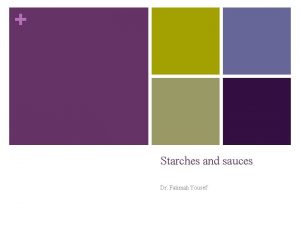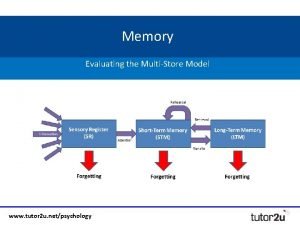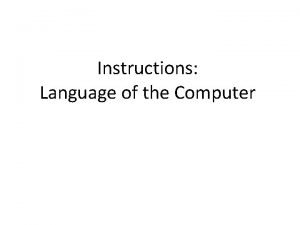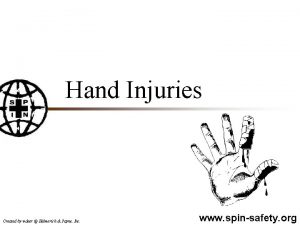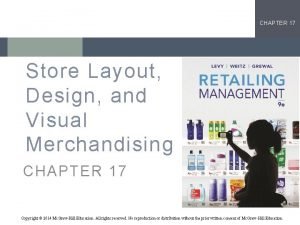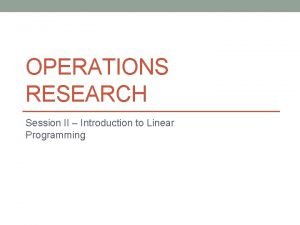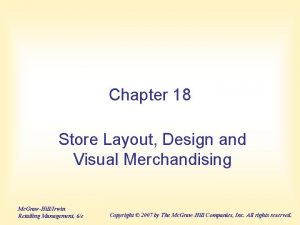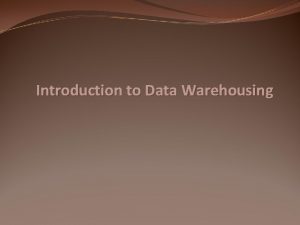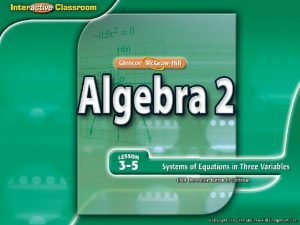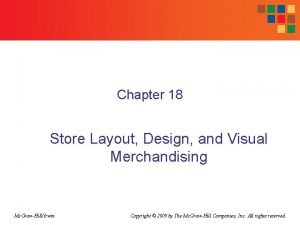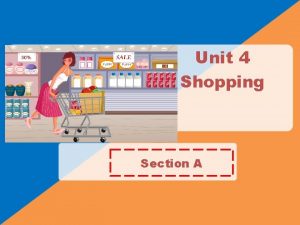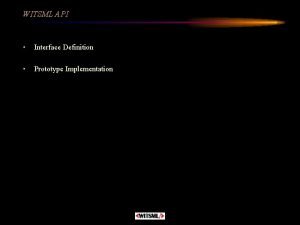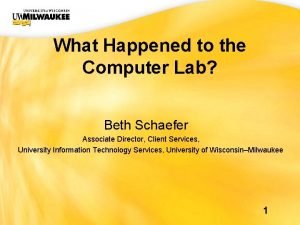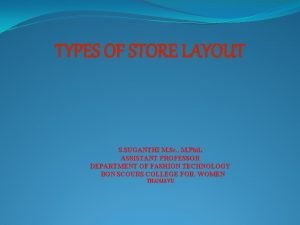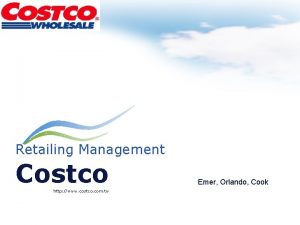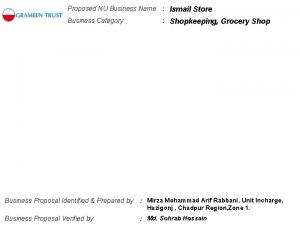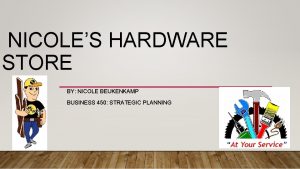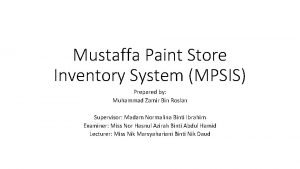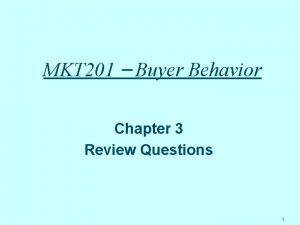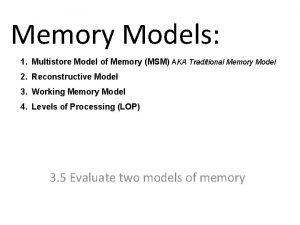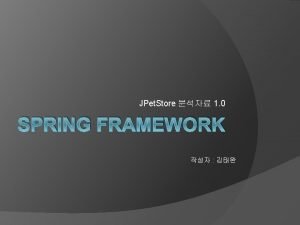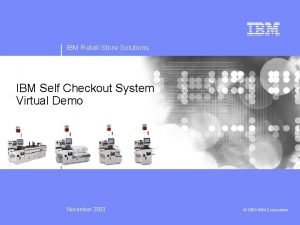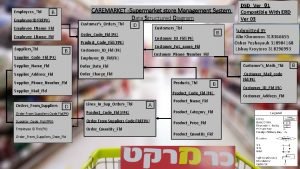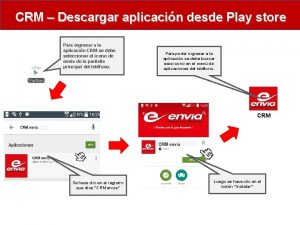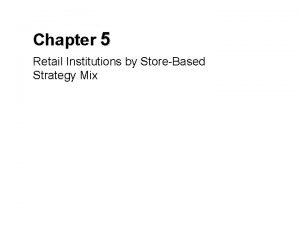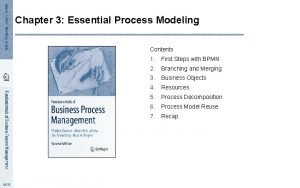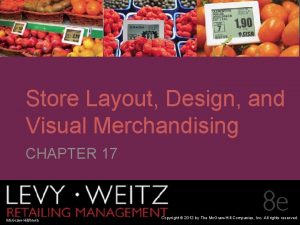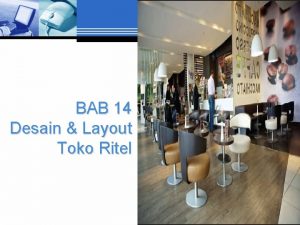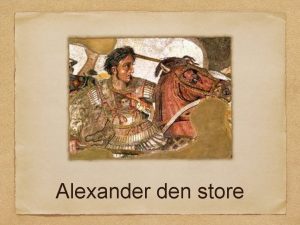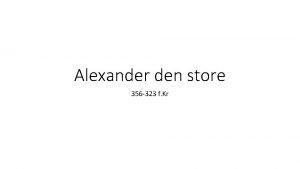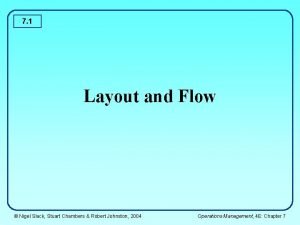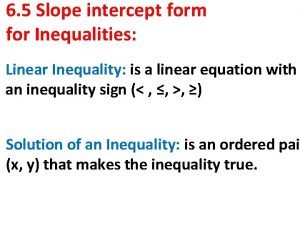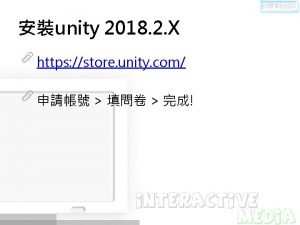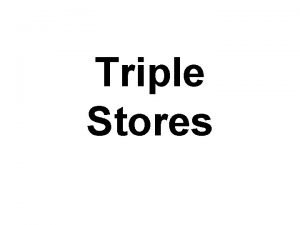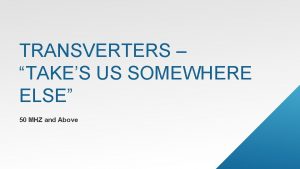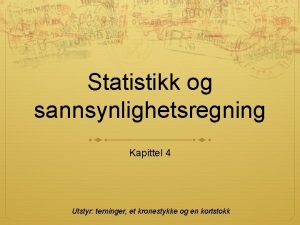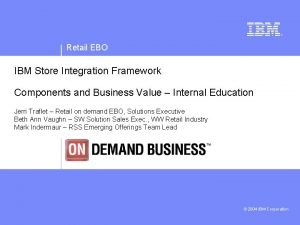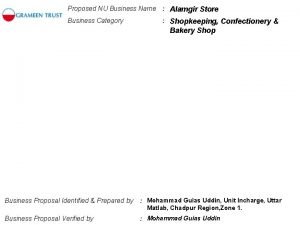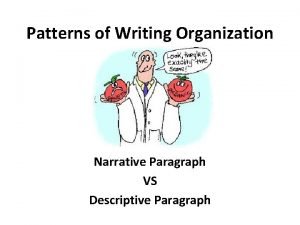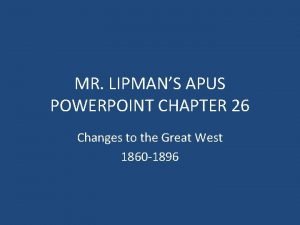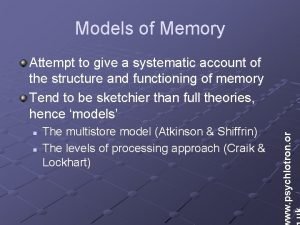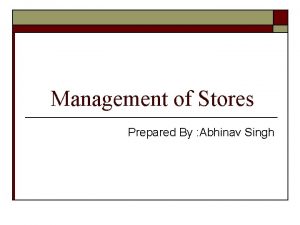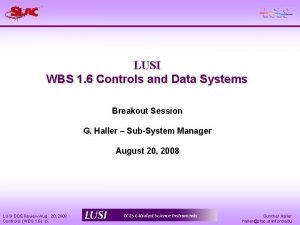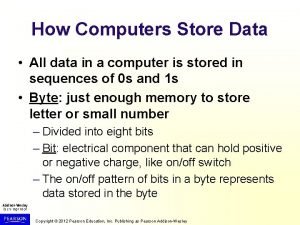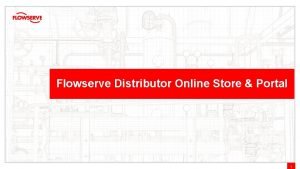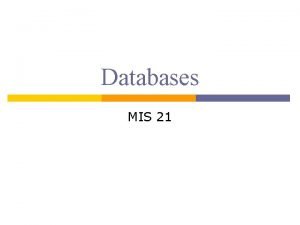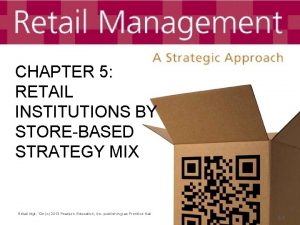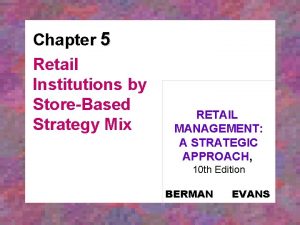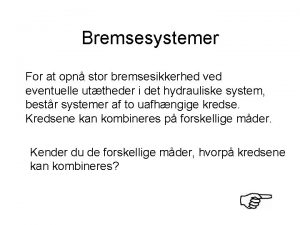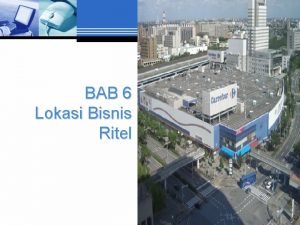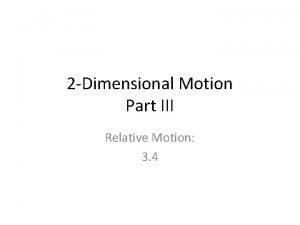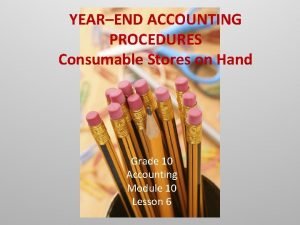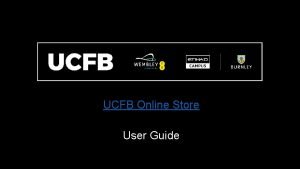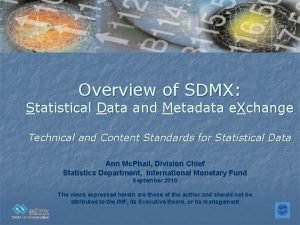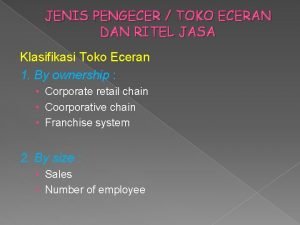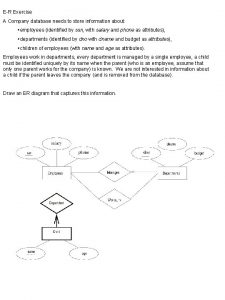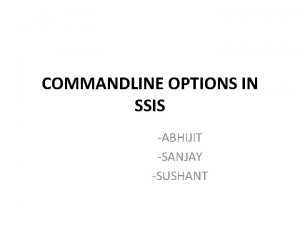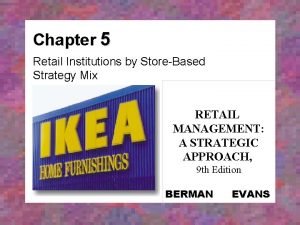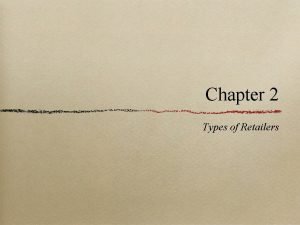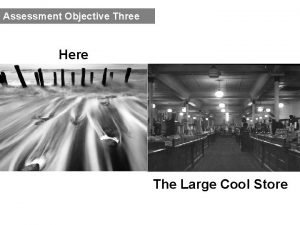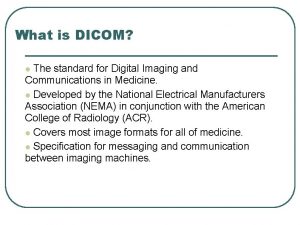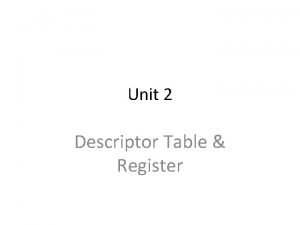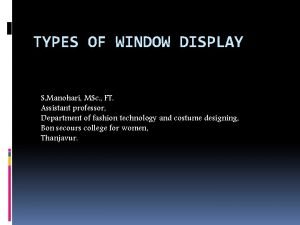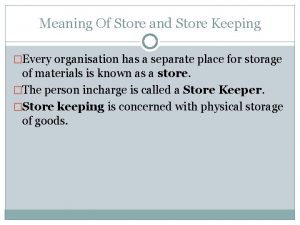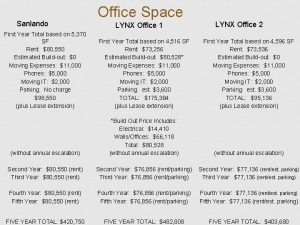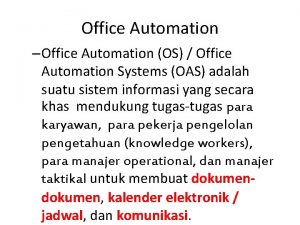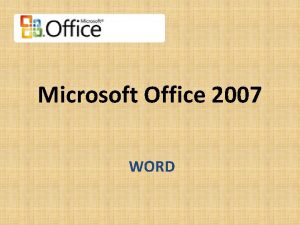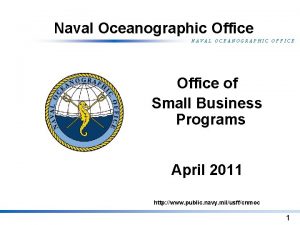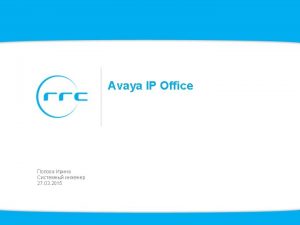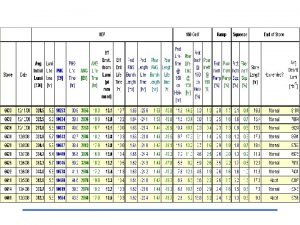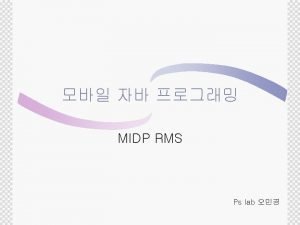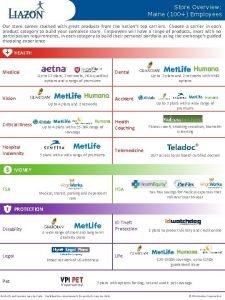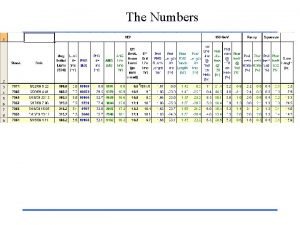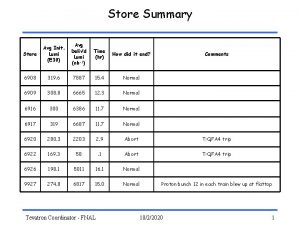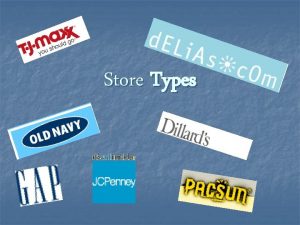P 16 Office and Store 1 Store 1






























![Economic order of quantity EOQ = Average Monthly Consumption X Lead Time [in months] Economic order of quantity EOQ = Average Monthly Consumption X Lead Time [in months]](https://slidetodoc.com/presentation_image_h2/fb1d2646c0fc2589f0acbcd1f8f364b8/image-31.jpg)





















































































- Slides: 116

P. 16 – Office and Store: 1. Store 1. 1 Procuring of office stationary and stores, Procuring of P. Way stores for maintenance and for special works, Classification of stores, Accountal of stores, DS- 8 note, RE-9 B, Material Transaction Order, Adjustment Memo, Stock verification reports, Disposal of Scrap & surplus stores, Overhauling of stores, Numerical ledgers & inventory control. Periods 4

OBJECTIVE OF PROCUREMENT THROUGH STORE

Store Organization in Zonal Railways : Headquarters level Divisional level and Extra Divisional or District level in the form of Stores Depots and Printing Presses.

Head-quarter level : At headquarters level, office of Controller of Stores is responsible for both coordinating various activities of stores depots and divisional controller of stores and also purchases.

Divisional level : Divisions have a Sr. Div. Controller of Stores or Div. Controller of Stores who is to coordinate with Controller of Stores to meet the material requirements of his Division. Depot level : The problems on Railways are more complex than those of a manufacturing organizations. There are thousands of indentors spread over a large geographical area. The Railways therefore, have to plan locations of the various stores depots with care.

Procurement of Stores : This includes purchase of materials of required quality and quantity at reasonable prices. This activity also includes development of sources of supply with due emphasis to development of ancillary industries, small scale industries and indigenous sources for imported items (import substitution). This also includes, maintaining constant touch with the market to ensure steady flow of materials. o

(b) Book & forms & stationary items : Demands for these items are to be submitted in prescribed printed forms (combined requisition cum issue note. ) Quantity demanded be as per the Quantity sanctioned. Normally 3/6 months requirement is issued at a time. Demands not complied are to be taken as canceled for future requirement

Functions of Stores Depot : (a) Material Planning : (b) Procurement of Stores : (c) Receipt & Inspection of Stores : (d) Store Keeping : (e) Distribution of Stores : (f) Collection, accountal and disposal of scrap : (g ) Inventory Control : (h) Cost Reduction : -

Classification Of Stores : Stock Items Non-Stock Items Frequently & regularly required, usually in large quantities Unit cost justifies incurring inventory carrying cost Not purchased very often Can be converted as Stock Item (to reduce the cost) when often purchased. Stocked in Depots and distributed Directly sent to the consignees/users.

1. 2. 3. 4. Classification Of Stores : Ordinary stores Emergency stores Surplus stores Special stores

1. Ordinary Stores : These are generally such items of stores for which there is a regular turnover caused by a constant demand. These may be further subdivided as New, Second hand Serviceable and Second hand repairable.

2. Emergency Stores : o These items are not readily available in the market and as such would require a long time for procurement in case they are not stocked. These are generally components of imported machines and Rolling Stock.

3. Surplus Stores Surplus stores are those items which have not been issued for the past 24 months and arise due to : Due to Changes in design/specification etc. of the Stock Items or stock items of stores which are no longer required by the consuming departments. Surplus Stores are classified as : (1) MOVABLE SURPLUS (2) DEAD SURPLUS Stores Depot should take steps for their suitable and speedy disposal.

SURPLUS STORES MOVABLE SURPLUS STORES DEAD SURPLUS STORES Stores items which have NOT been issued for 24 months but are EXPECTED to be issued in the near future. Stores items which have NOT been issued for 24 months and are NOT likely to be utilised on any Railway within the next two years.

4. Special Stores : The items of stores arranged and stocked for works and other special purposes i. e. other than for operation or ordinary maintenance and repairs are called "Special Stores".

Apart from above some other classifications as under are also prevalent on Indian Railways. 1. Custody Stores : These are stores which have been purchased for special works and charged to such works but due to inadequate stocking facilities available with

Other Classification Of Stores : 2. Imprest Stores : Certain important units like loco sheds, train examining depots etc. require a large number of items for day to day repairs, maintenance and operation of rolling stock. Imprest stores are standing advance of materials to meet the day to day requirement of repairs maintenance and operation of rolling stock etc. On most Railways the Imprest stores are charged off to the final head of Account under revenue working expenses. However, detailed A/c are maintained by these units and monthly Imprest recoupment schedules are sent by the Imprest holders to the nominated stores depots for bringing their stocks to the Imprest level sanctioned.

Classification of stores (Based on annual usage value) The stock items are classified into “A”, “B” and “C” categories based on annual usage value. The value limit fixed for categorising the stores varies every year. Category A B C Cumulative ANNUAL USAGE VALUE Annual Usage fixed by Southern Railway Value for 2010 -11 70% Above Rs. 34 Lakhs 20% From Rs. 4 to 34 Lakhs 10% Below Rs. 4 Lakhs


VED ANALYSIS • Based on critical value & shortage cost of an item –It is a subjective analysis. • Items are classified into: Vital: Shortage cannot be tolerated. Essential: Shortage can be tolerated for a short period. Desirable: Shortage will not adversely affect, but may be using more resources. These must be strictly Scrutinized V E D ITEM COST A AV AE AD CATEGORY 1 10 70% B BV BE BD CATEGORY 2 20 20% C CV CE CD CATEGORY 3 70 10%

Accountal & disposal of stores • DS 8 Note • RE 9 B • Material transaction order • Adjustment memo • Stock verification reports, • Disposal of Scrap & surplus stores, • Overhauling of stores, • Numerical ledgers & inventory control.

DS-8 NOTE (form no. S- 1539) The voucher prepared to transfer scrap to the depot or material returned to stores is known as DS-8 NOTE. It is prepared by scrap returning official in 6 copies. It must be signed by consignee as well as the controlling officer. Details- consignee code, allocation number, P L numer, description and quantity of material, rate, unit. Ist copy- office copy of material sender depot. IInd associated account , IIIrd issue voucher & IVth receipt copy kept by depot-copies should be sent along with material. Vth copy – to depot account. VIth copy- to division office. (to issuing official)

PROCEDURE FOR RETURNED STORES The Class-I materials so returned should be valued by the Depot Officer at the BOOK RATES. The scrap materials, so returned, should be valued at the rates given in the Schedule of Scrap (which is updated by the COS frequently with reference to the average prices realized at recent Auction Sales etc. ) and fed into the Computer. For condemned Rolling Stock and Scrapped Track materials, the DS -8 Voucher is retained by the DMS of the Stores Depot Ward, till such time the Sale Issue Note is prepared. The DS-8 Voucher and the Sale Issue Note concerned are simultaneously priced by the DMS before despatching to the Computer Centre.

RE-9 B (REVENUE EXCHANGE BOOK) cum adjustment memo When material is supplied from one sub- ordinate/works/divison to another the transaction is made on doccument called RE-9 B. It is prepared in six copies. Details- name of office /workshop/divisionto whom material is supplied, consignee code, allocation, P L numer, description and quantity of material, sanction number of work, head of A/C to which debit/credit. Based on RE-9 B tranfer voucher is prepared in the division office for adjustment. It is supporting voucher to transfer voucher.

RETURNED STORES Returned Stores may consist of : Surplus stores being balance of new materials that have not been used on work. Stores released from works Tools & Plants no longer required and Scrap All such materials should be RETURNED to a nominated Stores Depot with an Advice Note of Returned Stores in Form No. S-1539 (also known as DS-8).

NUMERICAL LEDGER AND INVETORY CONTROL Codification Of Stores : o Three types of codification systems ; Fully significant, Semi-significant and Non-significant.

All the Railway materials have been classified in 76 `Major Groups' or 'Main Groups' or groups. Each Major/main group (or groups) has been further classified into several sub-groups. Great care has been taken to ensure that groups and sub-groups do not overlap and the numbers have been allotted in a meaningful order and also they are unique. Each PL No. is sub-divided into 4 parts as under ; 90 35 058 3 Part A -- First Two Digits Part B -- Third and fourth digit Part C-- Fifth , Sixth and seventh digit Part D-- Last digit

Part `A' consists of two digits representing the main group of stores example main group is `90' which is for steel items. Part `B' consists of two digits representing sub-groups. Here `35' is the sub-group which is for various sizes of Mild Steel Flats. Part `C' consists of 3 digits and is the serial number of the item example serial number is 58. Part `D' consists of one digit which has a special significance with reference to computerization. his is the check digit. This digit is unique to a given number and is intended to check the integrity of the code number.

Inventory control It means stocking adequate number and kind of stores, so that the materials are available whenever required and wherever required. Scientific inventory control results in optimal balance

Functions of inventory control • To provide maximum supply service, consistent with maximum efficiency & optimum investment. • To provide cushion between forecasted & actual demand for a material
![Economic order of quantity EOQ Average Monthly Consumption X Lead Time in months Economic order of quantity EOQ = Average Monthly Consumption X Lead Time [in months]](https://slidetodoc.com/presentation_image_h2/fb1d2646c0fc2589f0acbcd1f8f364b8/image-31.jpg)
Economic order of quantity EOQ = Average Monthly Consumption X Lead Time [in months] + Buffer Stock – Stock on hand

Inventory Turn Over Ratio = (Total inventory balances in Rupees on 31 st March) ------------------------------- * 100 (Total value of stores issued during the year) The target for inventory turn over ratio is generally kept around 15%. The efficiency with regards to service is worked out by compiling compliance percentage of materials against all requisitions received in Stores Department. The target for compliance is kept between 95% to 98%. For vital and safety items, the compliance is aimed at 100%.

Stock verification Reports • As an important “back check” on the correct receipt and issue of stores by the Wards, it is necessary to have a departmental check to see whether the up to date balance of an item in the ledger agrees with the actual physical stock balance. Such departmental verification to be arranged by the depot officer will be in addition to the Stock Verification arranged by the Accounts Department.

Stock verification Reports • The departmental verification need only cover selected items such as items of large annual consumption having regular and frequent issues, items of heavy intrinsic value like non-ferrous items, tool steel, etc. , and items of a pilferable nature. A list of such selective items may be drawn up and approved by the Controller of Stores. The verification of physical balances should be done by an official other than the Ward-keeper-in-charge of the item of Stores. The depot officer may postpone the verification if the balances in stock are so heavy that a verification would involve large shifting of stock and the verification could be carried out conveniently at a later date

Stock verification Reports • The Depot Officer may waive verification in the following circumstances. — • (a) Where the item has been verified by the Accounts Department within the last three months. • (b) Where the Accounts Verification of the particular class of stores is in progress and, the item is likely to be verified within the next two months. • (c) Where the item has heavy balances the verification of which involves much labour and handling charges.

Stock verification Reports • A list of items the verification of which has been waived under (c) above should be prepared by the depot officer and forwarded to the Stores Accounts Officer through the Controller of Stores. • Procedure for verification. —The official deputed to verify the stock of an item should take down the opening balance in the ledger on the morning of the date of verification and proceed to verify the stock in the ward. He should note down the particulars of weighment, & c. , in a field book and obtain thereon the signature of the ward-keeper concerned in evidence of the correctness of the actual balances of stock entered therein.

Stock Verification Sheets: • If the physical balance or stock agrees with the book balance no stock sheets need be prepared. The official making the verification will merely make an entry in the ledger card/bin card to show that the physical balances agree with the book balances. The entry should be initialled by the official making the entry and the clerk- in-charge of the Ledger Section. • If there be an excess of stock or deficiency in stock, the official should prepare a Departmental Stock Verification Sheet in Form S. 1260 and dispose it as laid down in paragraph 1260.

Stock Verification Sheets: • Prepared in triplicate from the Field Book of SV in Form No. S 1260 • A Stock Verification Report has to be prepared at the time of posting the Priced Ledger showing the book balance, the ground balance as per the Stock Sheet and the excess / shortage, if any. • Numbering of Stock sheets serially for each unified group of stores Stock sheets / Stock Verification Reports for different categories and qualities of stores should be clearly so marked.

NEW PROCURMENT PROCESS 1. Ge. M: REPLACING DGS&D 2. THROUGH IRPES

Government e-marketplace Procurement Flow of Presentation • Learning Objective 1: How to Login as organisation/ Office and users on Ge. M • Two Stages • Step-1: Login as Organisation/Office • Step-2: Login as Secondary Users • Learning Objective 2: How to procure Goods & Services on Ge. M

Important Aspects of while procuring on Ge. M portal Parties in Ge. M Buyer Who can buy How to register to buy How to buy Seller Who can sell How to register to sell DGS&D Role and responsibilities

Each has its predefined role and responsibilities Steps for Login as Organisation/Office/HOD Step 1: Login to https: //gem. gov. in • Step 2: Click on Login/Register Webpage • Step 3: Fill the required login credentials and Click Login Click LOGIN

Steps to Procurement • Login as a Buyer • Go to the Market option • Select the required product category • Narrow down your selection by providing details of your requirement on three criteria • Select the desired product and proceed with purchase / adding to cart

Administrative Filter 1. Put the administrative filter 2. Quantity required 3. Delivery Location 4. Year of experience with government 5. Supplier Rating

Financial Filter 1. Put the financial filter 2. Product amount range 3. Annual turnover of the supplier 4. PMA-Value addition 5. Profit & Loss of supplier

Product Description Put the product technical specification as per requirement of buyer. • As brand • As model • Processor etc

Important Note • All filters applied by the buyer at the selecting product always remain on Ge. M and it may see by the HOD means the buyer have adequate justification as per requisite quality.

The Purchase Process – 141 A • If the total purchase amount upto Rs. 50, 000, • If the total purchase amount above Rs. 50, 000

Purchase Process 1. When the purchase amount is Less than. Rs 50, 000: • There is no need of doing comparison. • Buyer can select any product as per their specifications. 2. When the purchase amount is more Than Rs 50, 000: • It is mandatory to do comparison of the products first. • Buyer need to select the L 1 product.


Purchase Options 1. Direct Purchase 2. Bidding 3. Reverse Auction

Direct Purchase For the purchases in the above condition: • Go on product of screen and select product at top of right for comparison of products maximum upto four products. • Select the product(s). • If the amount is less than 50, 000 then buyer can go For any product. • Add to cart.

Direct Purchase And the same may“addtocart”by clicking on add to cart button. • Gotocartandselecttheproductwhichneedtobepurchasedand. Direct. Purchaseop tion.

Direct Purchase • The total purchase price upto. Rs. 50, 000 buyer may go for direct purchase by clicking direct purchase button. • Demand generation page will be displayed on screen. • Fill the required details and upload Financial Approval.

BUYER Select DDO along with Code • Fill Grant No. • Select Function Head • Select Object Code • Click On Block Budget

By filling the required information press submit button and OK to generate the demand.

• After clicking of Ok button, demand no. will be generated on screen and notification will be sent to the HOD, and Buyer.

Direct Purchase • • Go to main page and click on “manage product” menu and click on demand/order list. • Buyer will see different demand generated and click on process button.

Direct Purchase • By clicking on process button, buyer will find the sanction order page. • Click on Generate Sanction Order

Direct Purchase 1. Fill OTP on required box and e-sign it. 2. Buyer may see e-signed sanction order. 3. There after, click on approve and generate contract. BUYER

• DIRECT PURCHASE: contd. . These documents duly signed digitally (e-sign) by the Buyer will be made available online to the concerned DDO, PAO and Seller/Supplier. • The DDO and PAO shall have access to the Contract Agreement/Supply Order/Purchase Order online In order to ensure that the Bill is generated at the stage of payment in accordance with the contractuall provisions. An electronic signature, or e-signature, refers to data in electronic form, which is logically associated with other data in electronic form and which is used by the signatory to sign.

Direct Purchase • After generating the contract, the seller/supplier will dispatch the along with the issue of online invoice on Gem portal. • A invoice will be online available to the buyer and DDO/PAO regarding invoice cum bill. • Then Ge. M portal will send a SMS/email alert to the Buyer, on submission of Invoice.

Direct Purchase • After intimation of invoice, consignee needs to login. • The Buyer/consignee receives the Goods/Services and issues an online Provisional Receipt Certificate(PRC), within 48 hours, . . PRC. pdf • It contains the details regarding: • Quantity received • Date of receiving of consignment

Provisional Receipt Certificate (PRC)

CONSIGNEE • After verification Including assessment of quality and quantity, the Consignee will Issue on-line digitally signed Consignee's Receipt & Acceptance Certificate(CRAC) for that stage within 10 days of date of issue of PRC. . . CRAC. pdf • The CRAC would clearly indicate: • the Order quantity • rejected quantity (if any, with reasons for rejection including shortages/damaged/un accepted quality) • quantity accepted and cleared for payment

Consignment Receipt and Acceptance Certificate (CRAC)

• Notification regarding receiving of supplies will be sent to buyer, consignee, HOD and Supplier

DDO • After issuing PRC and CRAC, the in format ionregarding receipt and acceptance of goods has been sent to supplier on Ge. MPortal. • Now, DDO/PAO will login to process payment. • Login as PAO/DDO , go to manage products at the top. • Under Manage Products select Indent/Order list

• After selecting Indent/order list PAO/DDO will navigate to the demand/order list. • The latest demand generated will be displayed at the top. • Under the column Action, select Process

• After clicking on Process, payment authority will be navigated to “bill processing by HOD” page.


Payment Process PAO/DDO can have access to different documents namely: 1. Financial Approval 2. Sanction order 3. Contract 4. Seller Invoice 5. Provisional Receipt Certificate 6. Consignee Receipt and Acceptance Certificate 7. Buyer Bill process


Payment Process • • Click on Pay Using PFMS/SBI Payment gateway at the below.

If the total purchase amount above Rs 50, 000 Bidding and Reverse Auction • Bidding: -Bidding is an offer (often competitive) to set a price by an individual or business for a product or service or a demand that something be done. Bidding is used to determine the cost or value of something. • Reverse Auction: A reverse auction is a type of auction in which the roles of buyer and seller are reversed. In a reverse auction , the sellers compete to obtain business from the buyer and prices will typically decrease as the sellers under bid each other.

Bidding • If the buyer wants to participate in Bidding, then buyer needs to select the L 1 product and “add to cart” by clicking on add to cart button. • After adding the product to the cart and selecting to purchase, the buyer will have three options: Bidding, Reverse Auction and Direct Purchase. Select “BIDDING”.

• Fill the required details: • Delivery days • Mention the Bid start and end date. • Quantity • Extra specifications (ifneeded) • Clickon “CREATEBID”



2. If the total purchase amount above Rs 50, 000 For the purchases in the above condition: • Go on product of screen and select product at top right for comparison of products maximum up to four products. • Press compare button which shows on screen and OK. • Buyer will find a comparison sheet. • At the end of the comparison sheet, Ge. Mportal will display the L 1 to purchase amongst all the available product so n. Ge. Mportal.


If the total purchase amount above Rs. 50, 000 • And the same may “ add to cart ”by clicking on add to cart button. • Go to cart and select the product which need to be purchased. • The purchase price above Rs. 50, 000 then, buyer has three options:

If the total purchase amount above Rs. 50, 000 Reverse Auction • Select the products to purchase. • Ge. M portal will suggest the L 1 product. • Add to cart • After selecting the product in the cart, Ge. M will give three options: Reverse Auction, Bidding, Direct Purchase • Click on Reverse Auction button


Reverse Auction • Fill the required details: • Delivery days • Mention the RA start and end date. • Quantity • Step value decrement • Extra specifications (if needed) • Click on “Finalize RA”


• After clicking on “Create RA”, buyer will be navigated to Reverse Auction Details page where details about RA and product will be displayed. • Accept the terms and conditions and Click on “FINALIZERA”


IREPS Indian Railways E-Procurement System

• Minister for Railways announced in his Budget speech in year 2004 -05 that all procurement related activities to be done online. • • Pilot Project started in May 2005 on NR as NREPS (Northern Railway E-Procurement System) • 2008 -09 Downloadable tender form was made compulsory. Cost of tender form was to be submitted as separate instrument. • • 2010 stores e tendering started. In Sep 2008, CRIS hosted IREPS website for all Zonal Railways. CRIS is the agency for Developing all modules for IREPS in consultation with NR as the Co-ordinating Rly. 2016 Works e- tender was started. 2018 Online tender cost, EMD, E-TC and LOA, Bill Monitoring started Now all tenders are to be done through IREPS, hosted and managed by CRIS

• • • Online Creation & Publishing of Tender Document Online Creation & Publishing of Corrigendum Online TDC/EMD payments Online Submission of offers by Bidders Online Tender opening Process/ Automatic Generation of Comparative Statement Online Viewing of Offers/ Comparative Statement by Railway Users & Bidders Online Automated Creation of Briefing Note Item Directories (for Works tenders) o SOR & NS o Unified and/or Zonal, Department-wise Condition Masters and Document Masters

• Online Technical Evaluation of Offers (in 2 packet system) • Online Creation of Draft Tender Committee Minutes • Viewing/Signing of TC minutes by TC members o Adding of comments/suggestions by TC members, Modifications of TC minutes by convener • Online Submission of TC recommendations to Accepting Authority

• Acceptance/Modification/Return of TCR by AA with or without remarks • Submission of revised TC recommendations • Negotiations/ Counter Offer Online Creation and Issue of LOA Issue and Digital Signing of Contract by Railways & Successful bidder Online Creation and Publishing of Completion report Online raising of bill, its monitoring and payment

Modules in IREPS 13 Modules planned for IREPS. Out of which following 9 modules implemented ADMIN PARAMETERIAZATION (Back end module) RFQ (tendering, pre-bid meeting) BID (Bidding, Evaluation etc) including E-TC, including issue of LOA TRAINING (multimedia Training Kit) Help Desk PKI (Digital signature interface, Backend Module) ID (Interface development) Auction (reverse auction, Reverse sale)

v Remaining 4 modules under Development by CRIS o Contract (contract, amendment etc) o Contract Tracking (Dispatch, Receipt, Inspection, Invoice, Payment) o E-payment (Payment gateway, NEFT etc) o DRBC (Disaster recovery and Business Continuity)

Benefits of E-Procurement For Vendors • Complete Transparency • No possibility of Coercion • Offers can be modified any number of times and up to the time and date of opening of tender. The last offer made is the valid offer.

• No need to be physically present at tender opening place for dropping of tender / opening of tender. Comparative statement is available to all tenderers on their PC. • All offers / attachments are digitally signed by Vendor, hence cannot resile from the offer / documents at any later date. Thus, authenticity is ensured. • Generally competitive rates are received.

Benefits of E-Procurement For Railway • Complete Security as login is made with e-mail ID mapped to password, which is linked to digital signature with a matching Password and all the above duly encrypted with Encryption Certificate. • No possibility of late / Delayed tenders • Opening of tender can be done at any Convenient time after the scheduled date and time of opening as mentioned in tender. • Convenient Place of opening as any Computer with internet facility can be used where the Tender opening officials can sit together.

Benefits of E-Procurement For Railway • Corrigendum can be uploaded at any time up to date and time of opening of tender. • Further, the information regarding Corrigendum is immediately sent out as e-mail to all firms who have taken part in the tender. • No more botheration for arranging a physical tender Box, its location, accessibility, sealing, opening, and its security. • Technical Suitability / Unsuitability in Two packet system is intimated to all tenderers as soon as technical bid is evaluated.

Registration of Vendor Pre-requisites: Vendors need to have valid Class III Digital Signature with Firm’s Name and mapped to Unique E-mail ID issued by licensed CA They need to have a dedicated computer with latest Internet browser The drivers for the Digital signature is to be installed in the PC. Adequate Internet connectivity.

Registration of Vendor Go to Home page of IREPS. Open "New Vendors" link and fill login registration form to obtain User ID and password. Attach public key of DS. Thereafter, Login ID is activated. Login using Login ID and password, change password, to become a registered Vendor.

Registration of Railway User • CRIS has created various department under each Railway/Division as per Railways organisation structure. • Every department shall have an admin who will do all admin function for IREPS. • Admin shall have a DS and a EC. • Admin shall get himself registered as admin with CRIS by sending a authorisation letter from head of the office (PCE/DRM/Director). • Admin can create his organisation in IREPS on his own. • Railway User needs to have valid Class III Digital Signature issued by licensed CA in User’s Name and personal E-mail ID • Dedicated computer with the drivers for DS • Finance also need to register on IREPS with DSC.

ADMIN Once Digital Signature of the Nominated person is procured, the Public Key is to be sent to CRIS by e-mail with a request to assign this DS as administrator. This is confirmed by CRIS by return E-Mail. The power of Administrator includes assigning powers to various other member to (a) Open tender Box (b) Upload tenders (c) Co-ordination duties (such as attachments etc) (d) Nominate tender opening officials (Nomination may be done Day wise)

MINUMUM REQUIREMENT FOR E-PROCUREMENT 1. 2. 3. 4. 5. 6. DSC for all users (including TAA, TC members, Tender uploading / opening officials) in their individual capacity mapped to their personal E-Mail IDs 1 EC for the Organization as a unit Preferably one dedicated PC Good / Reliable Internet connection Nomination of 1 Admin Identification of Accounts / Stores counterparts and ensuring the DSCs for TC members, Tender Opening officials, Admin for Accounts / stores

3. BASICS OF TRACK PROCUREMEMT

STORES V/S WORKS CONTRACT Contract Works Stores Activity Execution of works Purchase Activity Centre Rly. Premises Supplier plant Governed by - Contract Act - GCC - Sales of Goods Act. Para 1220 of Engineering Code - IRS conditions GST - Interaction Continuous Assistance More – from Railways Site, Drawing Para 417 of Stores Code GST Intermediate Very Less (except issue of Rails)

TRACK PROCUREMENT Rails Railway Board Governed by Stores Code & IRS Conditions of Contract. Sale of Goods Act. Concrete sleepers Other P. Way Material Mostly Plants located on Railway Land. Zonal Railway Assistance in Procurement of Raw Material. Complete productions under Railway Supervision. Dispatches of sleepers through Railway Siding. No. outside order can be taken by plant without Railway’s permission. Though technically store contract but practically more like Works Contract

PROCUREMENT PROCESS (Presently Sequential) Vetted Indent Tendering Purchase Order Supply of Rails. (Switches, SEJ, GJ) Contract Handling SUPPLY OF MATERIAL

PROCUREMENT PROCESS (Presently Sequential)Appearing of Track Renewal Indent Tendering work in Pink/Law Book. Sanction of Detail estimate. Preparation of Indent. Vetting of Indent. Purchase Order Supply of Rails. (Switches, SEJ, GJ) Contract Handling Supply of Material

PROCUREMENT PROCESS (Presently Sequential) Indent Tendering Purchase Order Supply of Rails. (Switches, SEJ, GJ) Contract Handling Supply of Material

PROCUREMENT PROCESS (Presently Sequential) Indent Tendering Purchase Order Supply of Rails. (Switches, SEJ, GJ) Contract Handling Supply of Material Submission of SD Preparation of P. O. Vetting of P. O. Issue of P. O.

PROCUREMENT PROCESS (Presently Sequential) Indent Tendering Purchase Order Supply of Rails. (Switches, SEJ, GJ) Contract Handling Supply of Material Submission of B. G. by firm. Verification of BG. Board’s allotment for supply of rail. Advice to Railway concern for issue. Handling over of Rail to the Firm.

PROCUREMENT PROCESS (Presently Sequential) Indent Tendering Purchase Order Supply of Rails. (Switches, SEJ, GJ) Contract Handling Supply of Material Change in P. O. condition: Issue of M. A. ( Mod. Advice) D. P. extension. Change in Tax structure. Failure of material in field. Monitoring supply.

PROCUREMENT PROCESS Rubber pads Polyethylene dowel ERC (Pandrol clip) - Spring setting device Concrete sleepers GFN 66 liners CMS crossings Elastomeric pads Improved SEJ RDSO Switches - SGCI inserts SEJs Glued joint Metal Liners Plate & Rail screw Fish plate , fish bars Fish bolts , Fittings RITES

Risk Management in Procurement Risk Contingency Plan Delisting of supplier Failure of supplier Multiple or at least two suppliers for every track Failure of material in inspection. material. Failure of material in field. Non-extension of validity of offer by lowest Tenderer. Change in Specification. Change in Tax structure. Finalization within validity. 1. Timely initiate procurement process 2. Suitable explicit clause in contract Delay in Inspection. Regular chasing. Delay in arranging rail. Regular chasing.

Thanks
 Row store vs column store
Row store vs column store Row store vs column store
Row store vs column store Factory office plan
Factory office plan Characteristics of starch
Characteristics of starch Store and transmit hereditary
Store and transmit hereditary Pantry audits in research
Pantry audits in research Clive wearing tutor2u
Clive wearing tutor2u Simplicity favours regularity
Simplicity favours regularity Load and store instructions example
Load and store instructions example Inc
Inc Feature area in retail
Feature area in retail Functionalism vs structuralism
Functionalism vs structuralism Store layout, design and visual merchandising ppt
Store layout, design and visual merchandising ppt A retail store stocks two types of shirts a and b
A retail store stocks two types of shirts a and b Uses of convex mirror
Uses of convex mirror Mirror that curves outward
Mirror that curves outward Layout visual merchandising
Layout visual merchandising Operational and informational data store in data warehouse
Operational and informational data store in data warehouse The school store sells pens pencils and paper
The school store sells pens pencils and paper Idea-oriented presentation
Idea-oriented presentation Trims and accessories store department in garment industry
Trims and accessories store department in garment industry Do homework
Do homework Kurose
Kurose Witsml store
Witsml store Online puja store
Online puja store Uwm techstore
Uwm techstore Coast guard auxiliary uniform store
Coast guard auxiliary uniform store Threshold ap human geography
Threshold ap human geography Types of store layout
Types of store layout Specialty store retailer of private label apparel
Specialty store retailer of private label apparel Fixtures.qq
Fixtures.qq Store opgaver gymnasiet
Store opgaver gymnasiet Www.costco.com
Www.costco.com Objective of retail store operations
Objective of retail store operations Full line discount store
Full line discount store Executive house apartments state college
Executive house apartments state college Ismail varieties store
Ismail varieties store General merchandise examples
General merchandise examples Lovsang svensk
Lovsang svensk Ace hardware swot analysis 2020
Ace hardware swot analysis 2020 Current business
Current business Claudia norman a marketing consultant
Claudia norman a marketing consultant Kitchen cum store
Kitchen cum store Multistore model
Multistore model Lidl leadership principles
Lidl leadership principles What is an infrence
What is an infrence Jpet store
Jpet store Ibm self checkout
Ibm self checkout Jobeggs
Jobeggs Supermarket store management system
Supermarket store management system Back door delivery
Back door delivery Descargar app store
Descargar app store Best grocery store design
Best grocery store design Retail strategy mix
Retail strategy mix Essential process modeling
Essential process modeling Store layout definition
Store layout definition Managing the store
Managing the store Bible bucks
Bible bucks Jenis jenis layout toko
Jenis jenis layout toko Kolonier antikens grekland
Kolonier antikens grekland Alexander den stores häst
Alexander den stores häst 356 - 323
356 - 323 Layout and flow operations management
Layout and flow operations management A fish market charges $9 per pound
A fish market charges $9 per pound Retail location ppt
Retail location ppt Workload analysis of a large-scale key-value store
Workload analysis of a large-scale key-value store Wcu store
Wcu store Https://store.unity.com
Https://store.unity.com Triple stores
Triple stores Plate 160m ftv
Plate 160m ftv It hold data instructions and information for future use
It hold data instructions and information for future use Store talls lov
Store talls lov Ibm ebo
Ibm ebo Alamgir store
Alamgir store Narrative paragraph sample
Narrative paragraph sample Student services mt sac
Student services mt sac Lipmans party store
Lipmans party store Multistore model
Multistore model Advantages of decentralized stores
Advantages of decentralized stores Lusi cda
Lusi cda Uaf book store
Uaf book store How computers store data
How computers store data Flowserve store
Flowserve store Dynamo amazon's highly available key-value store
Dynamo amazon's highly available key-value store Markup vs discount
Markup vs discount A database consists of integrated tables which store
A database consists of integrated tables which store Capturing marketing insights
Capturing marketing insights константин i naissus
константин i naissus Retail strategy mix
Retail strategy mix Retail strategy mix
Retail strategy mix Retail organization and human resource management
Retail organization and human resource management Bremsekreds
Bremsekreds Ritel adalah
Ritel adalah Buying merchandise ppt
Buying merchandise ppt A pet store supply truck moves at 25
A pet store supply truck moves at 25 Yesterday we went shopping and then
Yesterday we went shopping and then What are consumable stores on hand
What are consumable stores on hand Maranda white
Maranda white Ucfb online shop
Ucfb online shop Where does cactus store water
Where does cactus store water Department store pronunciation
Department store pronunciation Http://sdmx.store:8080
Http://sdmx.store:8080 Income elasticity of demand
Income elasticity of demand Limited line store
Limited line store Httpsaka.ms/pbidesktop store
Httpsaka.ms/pbidesktop store Food label scavenger hunt worksheet answers
Food label scavenger hunt worksheet answers A company database needs to store information
A company database needs to store information Ssis 100 uta
Ssis 100 uta How was ernie caught during his jewelry store robbery
How was ernie caught during his jewelry store robbery Retail strategy mix
Retail strategy mix Difference between variety and assortment with examples
Difference between variety and assortment with examples Stacked membranes that receive store package
Stacked membranes that receive store package The large cool store larkin
The large cool store larkin What is dicom
What is dicom Hello my dear students
Hello my dear students The size of gdt table
The size of gdt table Type of window display
Type of window display
